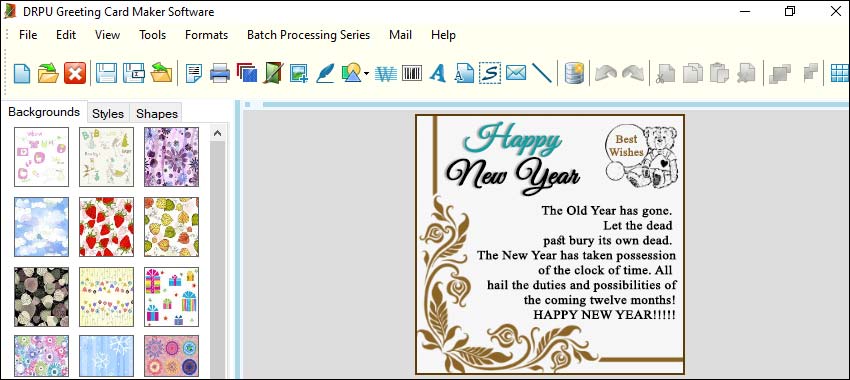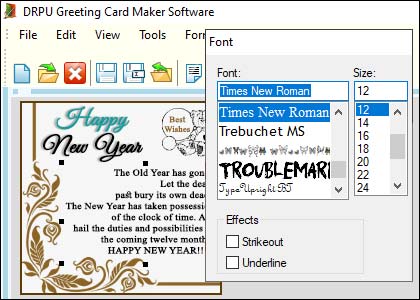The Essential Elements of a Greeting Card Design

-
Images: Images play a crucial role in greeting card designs, as they visually convey the theme, emotions, and messages of the card.
Greeting card designer tools offer several ways to incorporate images:
-
Image Libraries: Access preloaded image libraries within the tool, offering a wide range of illustrations, photographs, icons, and graphics related to different occasions and holidays.
-
Upload Your Images: Import your own images or photographs to personalize the card. This is particularly useful for adding recipient-specific pictures or memorable moments.
-
Image Editing: Many greeting card designer tools provide basic image editing features, allowing you to crop, resize, adjust colors, adjust settings, apply filters, and add effects to images.
-
-
Text: Text is essential for conveying messages, sentiments, and personalization in greeting cards.
Greeting card designer tools offer multiple ways to incorporate text:
-
Text Boxes: Use text boxes provided by the tool to add headings, subheadings, and body text. These can be placed anywhere on the card and customized in terms of font, size, style, color, and alignment.
-
Pre-designed Text Templates: Some tools offer pre-designed text templates for common greetings or messages, such as "Happy Birthday". Simply select the desired template and customize it as needed.
-
Handwriting and Calligraphy Fonts: Many greeting card designer tools provide a wide selection of handwriting or calligraphy-style fonts to add a personalized and artistic touch to the text of greeting card.
-
-
Layout: The layout of a greeting card determines how the images, text, and other design elements are arranged within the card.
Greeting card designer tools provide various layout options:
-
Pre-designed Templates: Start with pre-designed templates that offer predefined layouts for different occasions and holidays. These templates provide a foundation for your design, with placeholders for images and text that can be customized.
-
Layers and Grouping: Greeting card designer tools often have layering and grouping functionalities. These allow you to organize elements, manage their order and hierarchy, and ensure seamless integration between images, text, and other design components.
-
Drag-and-Drop Functionality: Most tools allow you to easily drag and drop images, text boxes, and other elements onto the card canvas. This enables you to experiment with different layouts and arrange the elements to achieve the desired composition.
-
When incorporating these elements using greeting card designer tools, it's important to maintain a balance and harmony within the design. Consider the overall visual appeal, legibility of the text, and coherence of the design elements to create an engaging and aesthetically pleasing greeting card.
Some Factors are Consider when Setting Prices
When pricing your greeting card design services, it's important to consider various factors that contribute to the value of your work. Here are some key considerations and factors to take into account when setting your rates:
-
Time and Effort:
Calculate the time and effort required to design each greeting card. Consider tasks such as concept development, research, sketching, digital rendering, revisions, and finalizing the design. Estimate the hours or days you spend on a project and factor in the level of complexity and detail involved.
-
Skill and Expertise:
Assess your skill level, experience, and expertise in greeting card design. If you have specialized knowledge or a unique artistic style, you may be able to command higher rates. Clients are often willing to pay more for exceptional craftsmanship and creative solutions.
-
Market Rates:
Research the market rates for greeting card design services in your region or industry. Compare prices charged by other designers or design agencies to gain an understanding of the prevailing rates. Keep in mind that rates can vary depending on factors such as location, target market, and competition.
-
Value and Quality:
Consider the value and quality you provide to clients. If your designs have a track record of success, have won awards, or have been featured in reputable publications, it adds value to your services. Clients may be willing to pay more for high-quality designs that meet their needs and exceed their expectations.
-
Client Budgets:
Take into account your target clients' budgets and their expectations for pricing. Large companies or high-end brands may have larger budgets for design services, while smaller businesses or individuals may have more limited resources. Align your pricing strategy with the specific market segment you are targeting.
-
Project Scope:
Assess the scope of each greeting card design project. Determine if it involves additional services such as custom illustrations, photo editing, or special printing techniques. More complex or extensive projects may justify higher rates due to the increased effort and resources required.
-
Licensing and Usage:
Consider whether your greeting card designs will be used for commercial purposes, such as mass production or resale. In such cases, you may need to negotiate additional fees or royalties for licensing usage rights. Factor in the potential for recurring revenue if your designs have an ongoing usage value.
-
Client Relationships:
Consider the nature of your relationship with the client. Repeat clients or long-term collaborations may warrant special pricing or discounts. Building strong relationships and providing exceptional customer service can lead to referrals and future business opportunities.
-
Overhead and Expenses:
Take into account your business expenses, including software subscriptions, hardware, marketing costs, professional development, and any other overhead expenses. Ensure that your pricing covers these costs and allows for a reasonable profit margin.
-
Flexibility and Negotiation:
Be open to negotiating your rates depending on the specific circumstances. Some clients may have specific budget constraints or unique project requirements. Evaluate the potential benefits of accepting a lower rate, such as expanding your portfolio or establishing relationships with influential clients.
In conclusion, Remember to regularly review and adjust your pricing strategy as your skills, experience, and market conditions evolve. Continuously assess the value you provide and remain competitive while ensuring that your rates align with the quality and effort you invest in your greeting card design services.
